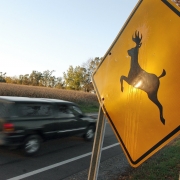The time of year for unexpected wildlife encounters
The transition from summer to fall for the average individual is often marked by brightly colored leaves, the return of seasonal favorites like hard apple cider and school being back in session. It’s also marked by the start of the migration season for many animals — something drivers will soon realize and possibly encounter, depending on where they live.
According to Farmers Insurance, 36% of comprehensive auto claims filed with Farmers due to accidents with animals occur between September and November, according to the previous five years’ worth of Farmers claims data.
“If you find yourself facing a potential accident with a deer or other animal, do your best to stay the course,” Jim Taylor, head of claims customer experience for Farmers Insurance, said in a statement. “It may sound counterintuitive, but staying the course may be safer for you and other vehicles on the road than swerving at high speeds in an attempt to avoid the animal.”
Expect the unexpected
Drivers can’t prevent animals from crossing the road, but they can exercise caution to stay safer during unexpected wildlife encounters. Taylor suggests drivers heed the following suggestions:
- Use your high beams: If appropriate, while driving at night (when there is no fog present or oncoming traffic) use your high beams to increase visibility and spot animals more easily. Since wildlife is often most active at dusk and dawn, sticking to daylight hours is ideal.
- Heed warning signs: Keep an eye out for wildlife crossing signs — they’re there for a reason.
- Stick to the middle lane: If you’re on a multi-lane road, staying in the middle lane may give you more time to spot an animal that may be crossing ahead of you.
- Know what to do if an accident occurs: If you hit an animal, pull over and call local law enforcement. They can direct you on what actions to take. Make sure you stay away from the animal since they may only be stunned and might panic if you come close, potentially harming you or your vehicle further.
- Get home safely: If you hit an animal, don’t assume your car is safe to drive. Look for any leaks, loose parts, broken lights and tire damage. If you spot issues or if your vehicle seems unsafe, have the car towed.
Contact your Ayres Group Agent if you have a vehicle encounter with wildlife that results in damage.



